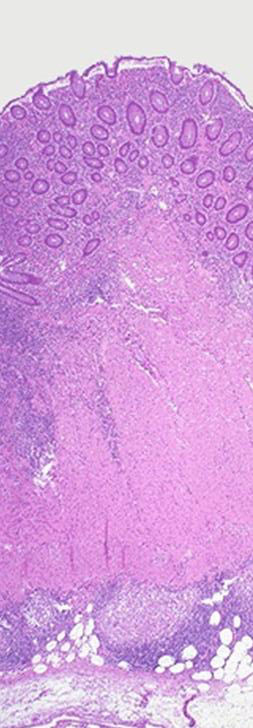Crohn's disease pathophysiology: Difference between revisions
| Line 5: | Line 5: | ||
==Overview== | ==Overview== | ||
==Pathophysiology== | ==Pathophysiology== | ||
===Gross Pathology=== | |||
There are certain characteristic features of the [[pathology]] seen that point toward Crohn's disease. Crohn's disease shows a transmural pattern of [[inflammation]], meaning that the inflammation may span the entire depth of the intestinal wall. Grossly, [[ulcer]]ation is an outcome seen in highly active disease. There is usually an abrupt transition between unaffected tissue and the ulcer. | |||
===Microscopic Pathology=== | |||
Under a microscope, biopsies of the affected colon may show [[mucosa]]l inflammation. Transmural inflammation results in formation of lymphoid aggregates throughout the wall of the colon. This inflammation is characterized by focal infiltration of [[neutrophils]], a type of inflammatory cell, into the [[epithelium]]. This typically occurs in the area overlying [[lymphoid tissue|lymphoid]] aggregates. These neutrophils, along with [[lymphocyte|mononuclear cells]], may infiltrate into the [[Crypts of Lieberkühn|crypts]] leading to inflammation (crypititis) or abscess (crypt abscess). [[Granuloma]]s, aggregates of [[macrophage]] derivatives known as giant cells, are found in 50% of cases and are most specific for Crohn's disease. The granulomas of Crohn's disease do not show "caseation", a cheese-like appearance on microscopic examination that is characteristic of granulomas associated with infections such as [[tuberculosis]]. Biopsies may also show chronic mucosal damage as evidenced by blunting of the intestinal [[villus|villi]], atypical branching of the crypts, and change in the tissue type ([[metaplasia]]). One example of such metaplasia, ''Paneth cell metaplasia'', involves development of Paneth cells (typically found in the small intestine) in other parts of the gastrointestinal system.<ref name=Robbins>Crawford JM. "The Gastrointestinal tract, Chapter 17". In Cotran RS, Kumar V, Robbins SL. ''Robbins Pathologic Basis of Disease: 5th Edition''. W.B. Saunders and Company, Philadelphia, 1994.</ref> | |||
[[Image:Crohn's transmural path.jpg|thumb|center|120px|H and E section of [[colectomy]] showing transmural inflammation.]] | [[Image:Crohn's transmural path.jpg|thumb|center|120px|H and E section of [[colectomy]] showing transmural inflammation.]] | ||
Revision as of 14:55, 12 August 2012
|
Crohn's disease |
|
Diagnosis |
|---|
|
Treatment |
|
Case Studies |
|
Crohn's disease pathophysiology On the Web |
|
American Roentgen Ray Society Images of Crohn's disease pathophysiology |
|
Risk calculators and risk factors for Crohn's disease pathophysiology |
Editor-In-Chief: C. Michael Gibson, M.S., M.D. [1]
Overview
Pathophysiology
Gross Pathology
There are certain characteristic features of the pathology seen that point toward Crohn's disease. Crohn's disease shows a transmural pattern of inflammation, meaning that the inflammation may span the entire depth of the intestinal wall. Grossly, ulceration is an outcome seen in highly active disease. There is usually an abrupt transition between unaffected tissue and the ulcer.
Microscopic Pathology
Under a microscope, biopsies of the affected colon may show mucosal inflammation. Transmural inflammation results in formation of lymphoid aggregates throughout the wall of the colon. This inflammation is characterized by focal infiltration of neutrophils, a type of inflammatory cell, into the epithelium. This typically occurs in the area overlying lymphoid aggregates. These neutrophils, along with mononuclear cells, may infiltrate into the crypts leading to inflammation (crypititis) or abscess (crypt abscess). Granulomas, aggregates of macrophage derivatives known as giant cells, are found in 50% of cases and are most specific for Crohn's disease. The granulomas of Crohn's disease do not show "caseation", a cheese-like appearance on microscopic examination that is characteristic of granulomas associated with infections such as tuberculosis. Biopsies may also show chronic mucosal damage as evidenced by blunting of the intestinal villi, atypical branching of the crypts, and change in the tissue type (metaplasia). One example of such metaplasia, Paneth cell metaplasia, involves development of Paneth cells (typically found in the small intestine) in other parts of the gastrointestinal system.[1]

References
- ↑ Crawford JM. "The Gastrointestinal tract, Chapter 17". In Cotran RS, Kumar V, Robbins SL. Robbins Pathologic Basis of Disease: 5th Edition. W.B. Saunders and Company, Philadelphia, 1994.